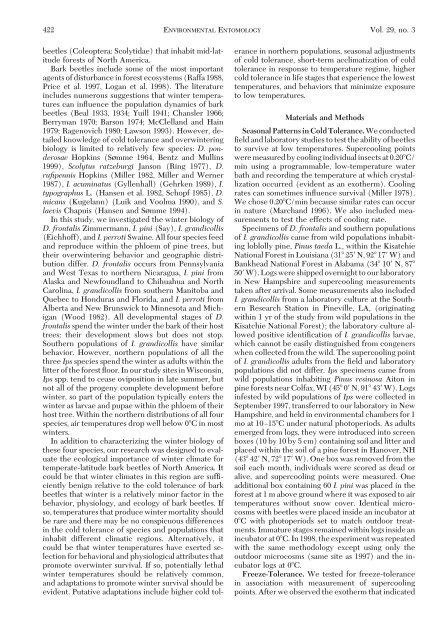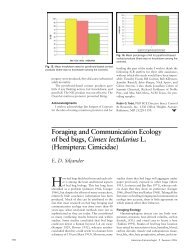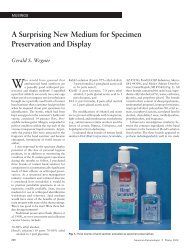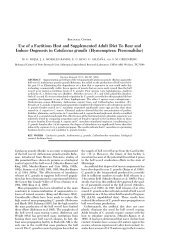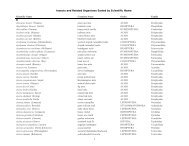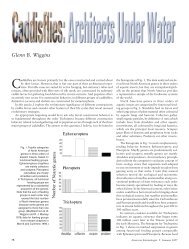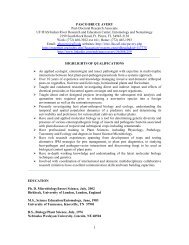Cold Tolerance of Four Species of Bark Beetle (Coleoptera ...
Cold Tolerance of Four Species of Bark Beetle (Coleoptera ...
Cold Tolerance of Four Species of Bark Beetle (Coleoptera ...
You also want an ePaper? Increase the reach of your titles
YUMPU automatically turns print PDFs into web optimized ePapers that Google loves.
422 ENVIRONMENTAL ENTOMOLOGY Vol. 29, no. 3<br />
beetles (<strong>Coleoptera</strong>: Scolytidae) that inhabit mid-latitude<br />
forests <strong>of</strong> North America.<br />
<strong>Bark</strong> beetles include some <strong>of</strong> the most important<br />
agents <strong>of</strong> disturbance in forest ecosystems (Raffa 1988,<br />
Price et al. 1997, Logan et al. 1998). The literature<br />
includes numerous suggestions that winter temperatures<br />
can inßuence the population dynamics <strong>of</strong> bark<br />
beetles (Beal 1933, 1934; Yuill 1941; Chansler 1966;<br />
Berryman 1970; Barson 1974; McClelland and Hain<br />
1979; Ragenovich 1980; Lawson 1993). However, detailed<br />
knowledge <strong>of</strong> cold tolerance and overwintering<br />
biology is limited to relatively few species: D. ponderosae<br />
Hopkins (Sømme 1964, Bentz and Mullins<br />
1999), Scolytus ratzeburgi Janson (Ring 1977), D.<br />
rufipennis Hopkins (Miller 1982, Miller and Werner<br />
1987), I. acuminatus (Gyllenhall) (Gehrken 1989), I.<br />
typographus L. (Hansen et al. 1982, Schopf 1985), D.<br />
micans (Kugelann) (Luik and Voolma 1990), and S.<br />
laevis Chapuis (Hansen and Sømme 1994).<br />
In this study, we investigated the winter biology <strong>of</strong><br />
D. frontalis Zimmermann, I. pini (Say), I. grandicollis<br />
(Eichh<strong>of</strong>f), and I. perroti Swaine. All four species feed<br />
and reproduce within the phloem <strong>of</strong> pine trees, but<br />
their overwintering behavior and geographic distribution<br />
differ. D. frontalis occurs from Pennsylvania<br />
and West Texas to northern Nicaragua, I. pini from<br />
Alaska and Newfoundland to Chihuahua and North<br />
Carolina, I. grandicollis from southern Manitoba and<br />
Quebec to Honduras and Florida, and I. perroti from<br />
Alberta and New Brunswick to Minnesota and Michigan<br />
(Wood 1982). All developmental stages <strong>of</strong> D.<br />
frontalis spend the winter under the bark <strong>of</strong> their host<br />
trees; their development slows but does not stop.<br />
Southern populations <strong>of</strong> I. grandicollis have similar<br />
behavior. However, northern populations <strong>of</strong> all the<br />
three Ips species spend the winter as adults within the<br />
litter <strong>of</strong> the forest ßoor. In our study sites in Wisconsin,<br />
Ips spp. tend to cease oviposition in late summer, but<br />
not all <strong>of</strong> the progeny complete development before<br />
winter, so part <strong>of</strong> the population typically enters the<br />
winter as larvae and pupae within the phloem <strong>of</strong> their<br />
host tree. Within the northern distributions <strong>of</strong> all four<br />
species, air temperatures drop well below 0C in most<br />
winters.<br />
In addition to characterizing the winter biology <strong>of</strong><br />
these four species, our research was designed to evaluate<br />
the ecological importance <strong>of</strong> winter climate for<br />
temperate-latitude bark beetles <strong>of</strong> North America. It<br />
could be that winter climates in this region are sufÞciently<br />
benign relative to the cold tolerance <strong>of</strong> bark<br />
beetles that winter is a relatively minor factor in the<br />
behavior, physiology, and ecology <strong>of</strong> bark beetles. If<br />
so, temperatures that produce winter mortality should<br />
be rare and there may be no conspicuous differences<br />
in the cold tolerance <strong>of</strong> species and populations that<br />
inhabit different climatic regions. Alternatively, it<br />
could be that winter temperatures have exerted selection<br />
for behavioral and physiological attributes that<br />
promote overwinter survival. If so, potentially lethal<br />
winter temperatures should be relatively common,<br />
and adaptations to promote winter survival should be<br />
evident. Putative adaptations include higher cold tol-<br />
erance in northern populations, seasonal adjustments<br />
<strong>of</strong> cold tolerance, short-term acclimatization <strong>of</strong> cold<br />
tolerance in response to temperature regime, higher<br />
cold tolerance in life stages that experience the lowest<br />
temperatures, and behaviors that minimize exposure<br />
to low temperatures.<br />
Materials and Methods<br />
Seasonal Patterns in <strong>Cold</strong> <strong>Tolerance</strong>. We conducted<br />
Þeld and laboratory studies to test the ability <strong>of</strong> beetles<br />
to survive at low temperatures. Supercooling points<br />
were measured by cooling individual insects at 0.20C/<br />
min using a programmable, low-temperature water<br />
bath and recording the temperature at which crystallization<br />
occurred (evident as an exotherm). Cooling<br />
rates can sometimes inßuence survival (Miller 1978).<br />
We chose 0.20C/min because similar rates can occur<br />
in nature (Marchand 1996). We also included measurements<br />
to test the effects <strong>of</strong> cooling rate.<br />
Specimens <strong>of</strong> D. frontalis and southern populations<br />
<strong>of</strong> I. grandicollis came from wild populations inhabiting<br />
loblolly pine, Pinus taeda L., within the Kisatchie<br />
National Forest in Louisiana (31 25 N, 92 17 W) and<br />
Bankhead National Forest in Alabama (34 10 N, 87<br />
50 W). Logs were shipped overnight to our laboratory<br />
in New Hampshire and supercooling measurements<br />
taken after arrival. Some measurements also included<br />
I. grandicollis from a laboratory culture at the Southern<br />
Research Station in Pineville, LA, (originating<br />
within 1 yr <strong>of</strong> the study from wild populations in the<br />
Kisatchie National Forest); the laboratory culture allowed<br />
positive identiÞcation <strong>of</strong> I. grandicollis larvae,<br />
which cannot be easily distinguished from congeners<br />
when collected from the wild. The supercooling point<br />
<strong>of</strong> I. grandicollis adults from the Þeld and laboratory<br />
populations did not differ. Ips specimens came from<br />
wild populations inhabiting Pinus resinosa Aiton in<br />
pine forests near Colfax, WI (45 0 N, 91 43 W). Logs<br />
infested by wild populations <strong>of</strong> Ips were collected in<br />
September 1997, transferred to our laboratory in New<br />
Hampshire, and held in environmental chambers for 1<br />
mo at 10Ð15C under natural photoperiods. As adults<br />
emerged from logs, they were introduced into screen<br />
boxes (10 by 10 by 5 cm) containing soil and litter and<br />
placed within the soil <strong>of</strong> a pine forest in Hanover, NH<br />
(43 42 N, 72 17 W). One box was removed from the<br />
soil each month, individuals were scored as dead or<br />
alive, and supercooling points were measured. One<br />
additional box containing 60 I. pini was placed in the<br />
forest at 1 m above ground where it was exposed to air<br />
temperatures without snow cover. Identical microcosms<br />
with beetles were placed inside an incubator at<br />
0C with photoperiods set to match outdoor treatments.<br />
Immature stages remained within logs inside an<br />
incubator at 0C. In 1998, the experiment was repeated<br />
with the same methodology except using only the<br />
outdoor microcosms (same site as 1997) and the incubator<br />
logs at 0C.<br />
Freeze-<strong>Tolerance</strong>. We tested for freeze-tolerance<br />
in association with measurement <strong>of</strong> supercooling<br />
points. After we observed the exotherm that indicated


